Bazaars, museums, architecture and designer cafes – Kosovo’s biggest city does it all incredibly well. This culture and coffee-oriented guide covers the best things to do in Pristina Kosovo plus recommended side trips.
Of all the big Balkan cities I visited on my six-month trip around the region, I think Pristina (also written as Prishtina or Prishtinë) surprised me the most.
As well as being the youngest European capital, it’s definitely one of the most underrated.
Unlike many first-time travellers to Kosovo, we didn’t start our trip in Pristina, we ended it there. I’m not sure if my impressions would be different had we done our Kosovo itinerary in reverse, but ending in the capital was the right choice for us and certainly felt like finishing on a high.
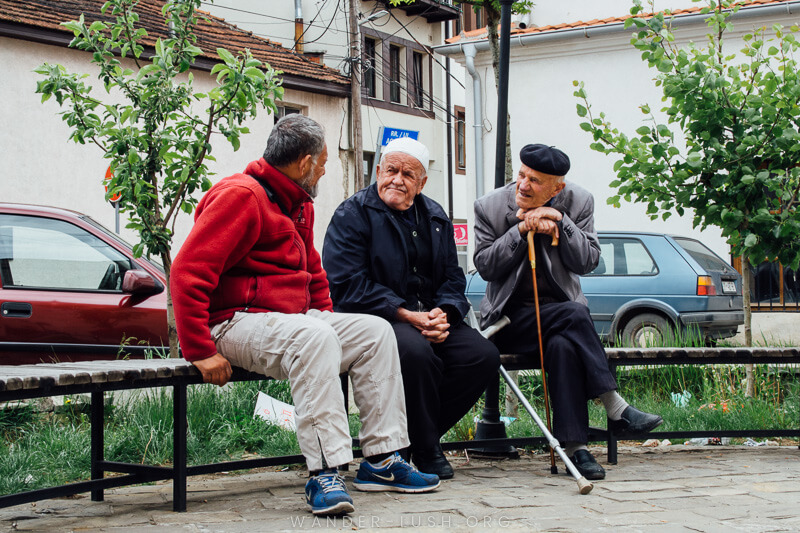
Prizren is considered Kosovo’s cultural hub, Gjakova the prettiest city, and Peja is the gateway to nature. Having already experienced all three, we found Pristina, the largest city and most cosmopolitan, to be a nice combination of all of the above – with some unexpected and fascinating architecture thrown in.
Laid-back and lively all at once, with a hip cafe and bar scene and some fantastic outdoor public spaces, Pristina is a beautiful city and one of my top choices to include on your Balkans itinerary.
Here are my favourite things to do in Pristina plus a map, travel tips, suggested Pristina itinerary, and more.
Please note: This post contains affiliate links, meaning I may earn a commission if you make a purchase by clicking a link (at no extra cost to you). Learn more.
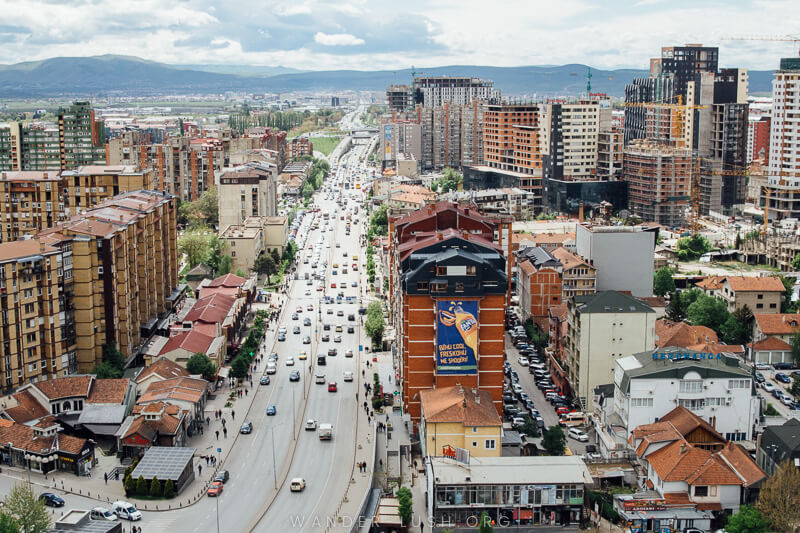
Where to stay in Pristina
Pristina offers a good mix of budget and mid-range accommodations plus plenty of apartment rentals. It’s also home to the finest boutique hotel in Kosovo, the social-focused Hotel Gračanica.
Boutique: If you want to experience Kosovo’s first boutique hotel, Swiss-run and multi-ethnic-owned Hotel Gračanica is superbly styled, with a luxurious pool and an on-site restaurant. It’s located 15-20 minutes’ by taxi (a 5 Euro fare) from Pristina, close to Gračanica Monastery. Even if you aren’t staying the night, you can still visit for the day – you’ll find it featured later on my list of things to do in Pristina.
Mid-range: Stay Ok is a good no-frills choice. A room at City Inn will set you back a few more Euro, but the stylish decor and central location are worth it.
Budget: ODA Hostel (dorms + privates with shared bathroom) is the top choice among Pristina’s hostels.
Self-contained: When researching for our visit, we were surprised at how many cool apartment rentals there are in Pristina. We ended up staying at an Airbnb inside the iconic Kurrizi Complex. I’ve gone to the liberty of curating a list of the city’s most stylish Airbnb apartments – find it here.
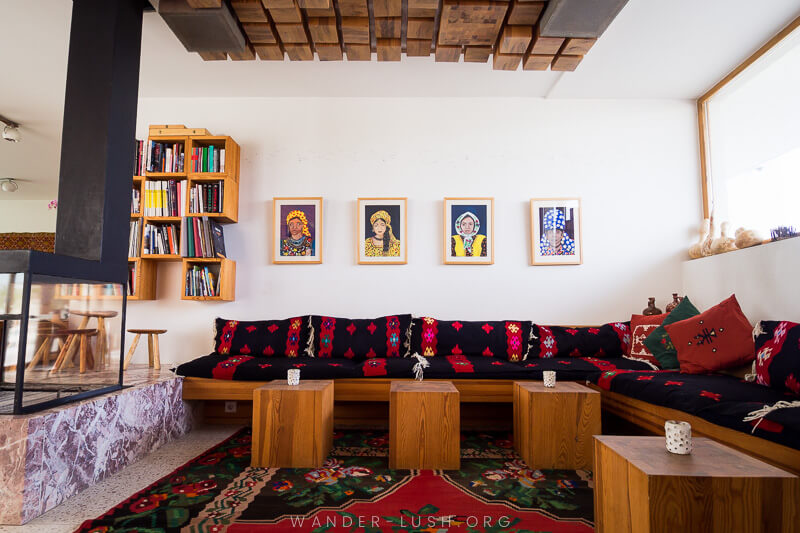
Getting around Pristina
Pristina city centre is compact and flat; everything on this list (apart from Hotel Gračanica and the Bear Sanctuary Pristina) can be reached from the centre on foot.
A DIY walking tour is a great way to take in the highlights. Information tablets have been placed throughout the city to mark important landmarks, and there are large tourist maps positioned prominently on every other block.
Just know that Google Maps isn’t always reliable, especially on the back streets around the Ethnographic Museum.

I’ll admit that I don’t know anything about public transport in Pristina because we never had occasion to use it. You can read-up on Pristina’s city buses here.
If you prefer to explore the city with a guide, I recommend this private 3-hour walking tour of the city centre.
12 wonderful things to do in Pristina
Wandering what to do in Pristina? Here’s my culture and coffee filled guide to the best things to do.
1. Climb the cathedral tower for a view of the city

Whenever I arrive in a new city, I like to start with a bird’s eye view so I can better visualise its size and layout. By this stage of my Balkans trip, I honestly couldn’t count the number of clock towers, bell towers, fortresses and hillocks I’ve climbed!
The tower adjoining the Cathedral of Saint Mother Teresa is the best vantage point in Pristina and a must-do. From 250 feet up, you can look down on Miti Park and the iconic National Library of Kosovo to the east. To the south and west, Pristina’s suburbs – huge conglomerations of socialistic-style concrete blocks – roll out along sparkling highways.
The tower is accessible by elevator and entrance costs 1 Euro. There are no official opening hours that I could find, but locals assure me the tower is open daily until sunset, with a short break in the middle of the day for lunch.
2. Go inside the Cathedral of Saint Mother Theresa
While you’re there, take a moment to visit the church itself. The biggest Catholic cathedral in Kosovo, it only opened to worshipers in 2009.
I’ve really enjoyed observing the differences between Orthodox and Roman Catholic churches in the Balkans, and the contrast in Pristina couldn’t be starker. Everything is shiny and new, and the sparsely decorated, spacious interior truly sparkles.
Take note of the stained glass windows that line both sides of Saint Teresa Cathedral’s nave and the pews adorned with eagle heads. The Saint Teresa window pictured was gifted to the church by a benefactor with the family name, Lush!
3. Wander down Mother Teresa Boulevard

Pristina is very much an outdoor city and as long as you’re not visiting in winter, you’ll find the streets are always alive with cafes, flower markets and groups of friends out for a stroll.
Traipsing up and down the cobbled streets around Shadervani and along Agim Ramadani Street, the main drag, is an activity in itself. The pedestrian-only Mother Teresa Boulevard (Bulevardi Nënë Tereza) is lined with shady trees and delightful little shop cubes, where stallholders trade blossoms and second-hand books.
A small farmers’ fresh produce market is also held on the street every morning.
Watch elderly gents, always in pairs, chatting away the afternoon while groups of friends crisscross the boulevard, hopping from one trendy cafe to the next. Pause for just a moment and someone is bound to approach you and strike up a conversation.
In the evenings, most of these venues transform into bars, serving craft brews, wine by the glass and draught beer.

At its northern end, Mother Teresa boulevard terminates at Skanderbeg Square, where an imposing statue of the Albanian general stands in wait.
4. Stop for coffee at Soma Book Station
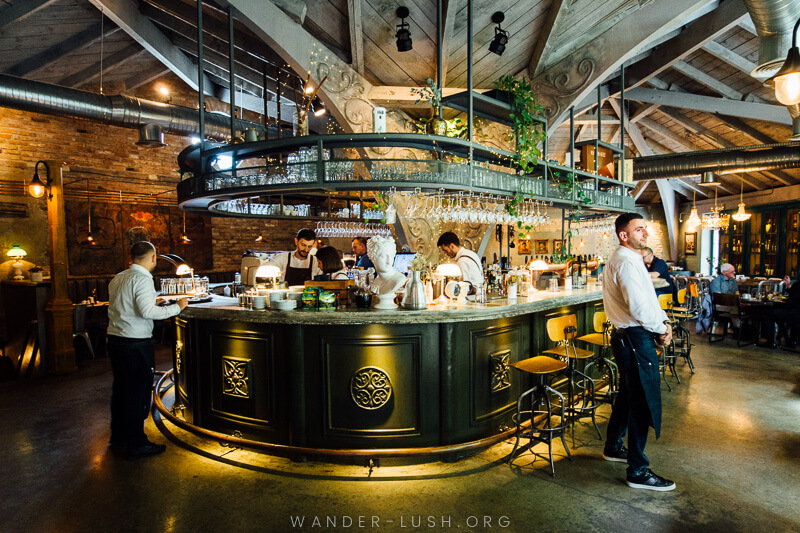
Not familiar with Kosovo’s coffee culture? I have two words for you: Big macchiato.
A close cousin of the Australian flat white, the humble macchiato is the beverage of choice across Kosovo. (Put that Turkish coffee away!) Hand on heart, coffee in Kosovo is the smoothest and tastiest I’ve had since we left Colombia, and probably the best I’ve had anywhere in Europe (sorry, Italy).
Even the smallest, most unassuming (and downright dodgy looking) cafes make a mean macchiato. Kosovar baristas sure know how to work an Italian coffee machine – and a big macchiato will never cost you more than 1 Euro (the cheapest we had was 80 cents, and it was still fantastic!).
Prince Coffee House (a Kosovar chain that recently opened a branch in The Bronx) is probably the most popular cafe in Pristina. But my personal favourite place to grab a drink is definitely Soma Book Station.
5. Visit the Imperial Mosque

There are more than 500 mosques in Kosovo. If you’re going to visit just one in Pristina, make it the Sultan Mehmet Fatih Mosque, an active mosque and one of the city’s most revered cultural monuments.
Known locally as the Imperial Mosque (Džamija cara), it was constructed in 1461 and is a stunning example of Ottoman architecture. It’s definitely more restrained than other mosques I’ve seen in the region but just like the nearby cathedral, it has an understated beauty. The stone ablution fountain, set in the front garden, is particularly impressive.
I’m not entirely sure of the visitor’s policy at the Imperial Mosque. After some confusion over whether or not we should buy a ticket, we were shown inside free of charge (although our chaperone didn’t turn the lights on for us, maybe because he didn’t know where the switch was!).
There is an Islamic bookstore on the street just below the mosque where you can usually find someone to let you in. If there’s no one there, don’t fret: I actually thought the paintings on the exterior domes were just as impressive as the interior.
On the same street, the petite Jashar Pasha Mosque (Xhamia e Jashar Pashës) and the 15th century Bazaar Mosque (Xhamia e Çarshisë) are also worth a look in. The latter is among the oldest surviving structures in Pristina.
6. Lose yourself in Pristina’s old market, Tregu i vjeter

We got completely disoriented trying to navigate our way from the mosque to the Ethnological Museum and happened upon a raging green market in the winding back streets. We later learned that Tuesday is market day in Pristina, when the alleys around what used to be the Pristina Bazaar fill up with fruit, veg and dairy vendors from the surrounding villages.
In the 16th century, the Pristina Bazaar was known throughout the region as a trading hub. At its peak, it contained more than 300 shops, as well as a hammam and a mosque. Sadly, most of the complex was destroyed in the 1960s as part of the city’s urban ‘regeneration’ program. From old photos, it looked a lot like the bazaar in Gjakova, which is the biggest in Kosovo today.
The buildings may be gone, but the tradition still continues. Inside a permanent undercover market adjacent to the Ethnography Museum people sell electronics, hardware and other products.
To see the green market in action and the streets abuzz with shoppers and men pulling wooden carts, you should try to time your visit for a Tuesday morning.
7. Step back in time at the Pristina Ethnographic Museum
Keeping with the regional tradition of turning former private residences into house museums , Pristina’s Ethnological Museum (also called The Ethnological Treasure of Kosovo) is set in the Emin Gjiku Complex, an 18th-century property that belonged to one of Pristina’s wealthiest Kosovar-Turkish families.
Three buildings, each one with outstanding architectural flourishes, house artefacts collected from Pristina and around Kosovo between the 15th and 20th centuries. Textiles, furniture, dowry trunks and kitchen utensils tell the story of how the city’s traders once lived and practiced their culture.
In the sitting room, a raised bench for guests and lowered seating for the family speaks to the Albanian tradition of welcoming outsiders unequivocally into one’s home. The museum curator told us the house was even used to shelter Jewish refugees during the war.
Two of the museum’s three buildings were closed for renovation at the time of our visit, but luckily we could still tour the main house. The curator is usually on hand to show guests around (note that the museum is closed on Mondays). Entry is free, but donations are appreciated. More information and opening hours can be found here.
8. Go inside the National Library of Kosovo
Does the National Library of Kosovo deserve the title of the world’s ‘ugliest’ building? I’ll let you be the judge. Wherever you fall, I think it’s worth a visit – if only to see the unusual facade of the building, which looks like a huge coil of chain, up close.
Completed in 1982, the library’s design is the fever dream of Croatian architect Andrija Mutnjaković. Its more-redeeming design features can be found inside: A stunning geometric floor mosaic (it’s actually tiered with shallow stairs) dominates the entryway.
There are some nice wall mosaics and retro fittings among the semi-abandoned upstairs rooms.
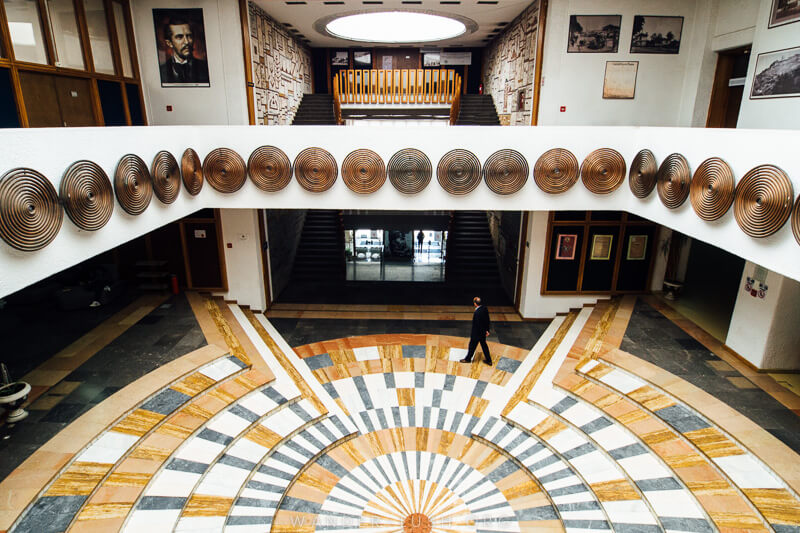
Visitors get free reign inside the library, including the upstairs reading rooms. I feel a pang of sadness whenever I see books being mistreated: I’m sure staff here are doing their best (and there were a lot of them – and visitors – around), but we saw a lot of disheveled piles and ripped books laying about. In one of the rooms, there is a conveyor belt that looks as if it hasn’t been used in decades.
The best views of the library are available from the cathedral tower.
9. Take a selfie at the Newborn Monument

Another Pristina icon, the Newborn monument was unveiled on 17 February 2008, the day Kosovo declared its independence. Every year, to mark the anniversary of the declaration, a different artist is invited to reimagine and reinvigorate the monument by repainting it with different motifs – usually designed to echo broader political or cultural conversations.
In 2019, Newborn was decorated with patterns to represent energy, water, oxygen, nature, biodiversity and recycling.
Make sure you also visit the much more sombre Heroinat Memorial opposite Newborn, which pays tribute to the women victims of the Kosovo War.
10. Visit the Kurrizi Complex, Pristina’s biggest housing estate

As you’ve probably guessed from my recent dispatch from Bratislava, I’m fascinated with socialistic-style housing projects and Brutalist architecture. When I studied architecture history as part of my bachelor’s degree, this was one of the topics I chose to focus on!
Like all major cities in the region, Pristina has a number of large-scale modernist housing projects – civilian microcosms that were intended to be self-sustaining. Dardania and Ulpiana are two Pristina neighbourhoods where this post-1945 style of robust architecture – dominated by concrete, glass and iron – prevails.
The Kurrizi Complex is another great example. Meaning ‘Spine’, it was designed by Yugoslavian state-owned firm Plan Zagreb and remains the largest shopping and housing project in the city. It comprises three sections: A ground floor with an enclosed shopping street and tunnel so that cars can pass under the building (cool!); a 400 metre ‘boulevard’ lined with more shops; and multi-storey housing towers with hundreds of apartments.
We were lucky enough to stay in an Airbnb inside Kurrizi Complex – it was a very unique experience! Even if you just drop by for a visit, it’s a fun place to observe a slice of daily Pristina life.
There are plenty of cafes and bars on the boulevard level where you can stop for a drink. One of the bakeries inside the complex (just to the left of the market pictured above) makes the best burek I ate in Kosovo.

The Kurrizi Complex is located directly behind the statue of American President Bill Clinton and the nearby ‘Hillary’ boutique – two of Pristina’s quirkier tourist attractions.
11. Take a side trip to Gračanica Monastery & Hotel

I was lucky enough to visit all four of the monasteries that make up the UNESCO-listed Medieval Monuments in Kosovo. Gračanica Monastery was probably the most relaxed and tranquil of the lot.
Only 10km or less than 30 minutes from downtown Pristina by bus, it’s an easy side trip from the capital and well worth the journey.
While you’re in the area, I highly recommend stopping for lunch at the nearby Hotel Gračanica. A Swiss-operated hotel, it’s one of very few venues in Kosovo that employs people from a range of ethnic backgrounds (Kosovar, Serb and Roma), including in management positions. The hotel has serious eco credentials and there’s also a pool that you can pay to use. Even better, you can spend the night and use all the facilities as a guest.
The interior decoration is on-point and the food is delicious.

Getting to Gračanica from Pristina couldn’t be easier: Just take a bus bound for Gjilan and ask the driver to let you off early. The trip takes 15 minutes and costs a couple of Euros.
Contrary to some reports online about ethnic tensions in the predominantly Serb Gračanica, bus drivers don’t seem to have any issue with taking tourists to the monastery – at least in our experience.
12. Take a side trip to Badovc Lake & Bear Sanctuary Prishtina
This accredited ethical animal sanctuary houses 20 rescued brown bears on a beautiful 16-hectare property just east of the city.
Visitors are welcome to explore the facility and eat at the onsite restaurant, with proceeds going to support Bear Sanctuary Pristina’s work to rescue mistreated animals. The nearby Badovc Lake is accessible via a hiking trail from the sanctuary.
To get to the Bear Sanctuary from Pristina you can take a Gjilan regional bus or a Blue Taxi for €12 one-way. See here for details.
Where to eat & drink: Best Pristina restaurants
If you need a wee break from Balkan cuisine, Pristina is a great place to reset your palate. We only ate out a couple of times and cooked at home (read: ransacked the local bakery!) the rest of the time.
If we ever make it back, we’ll have to remind ourselves to check out more of the international dining options, including Himalayan Gorkha Restaurant and one of the many Mexican joints in town.
Home Restaurant & Bar | This cosy traditional restaurant is a Pristina institution and favourite among expats. The menu covers both Balkan and European cuisines, and the Lebanese salad with hummus and falafel is to die for.
Restaurant Liburnia | Veal tava (sauteed veal with veggies) is the specialty at this beautiful restaurant. For the best experience, sit outside beneath the vines.
Thai Restaurant | Finding good Asian food in the Balkans feels like stumbling on El Dorado. As soon as the owner of the laconically named Thai Restaurant greeted us with an animated sawatdee kaaaa, we knew we were in for a treat. We ate two curries, massaman beef and chicken pineapple. Both were a little thin but tasted top-notch.
Fehmi Agani ‘Bar Street’ | Another dining hub in Pristina, ‘Bar Street’ is a great place to grab a drink. Try MIQT for craft beers from around Kosovo plus rakia.
Hamam Jazz Bar | Experience Pristina nightlife at this popular club.
Pristina map
Click here to open & save my Pristina Map on Google Drive.
How to spend a day in Pristina: Suggested Pristina itinerary
Whether you’re planning a short city trip or using Pristina as your entry point for a longer journey around Kosovo, here is how I suggest you structure your one day in Pristina.
Morning:
- Breakfast at Soma Book Station (open from 8am Monday-Saturday)
- Visit Pristina’s three mosques
- Pristina Ethnographic Museum
- Old Green Market area
- Lunch at Liberna or Home Restaurant
Afternoon:
- Mother Teresa Cathedral & belltower
- The National Library of Kosovo
- Bill Clinton statue
- Kurrizi Complex
Evening:
- Dinner & drinks on Fehmi Agani
How to get to Pristina
Pristina Airport is serviced by flights from Munich, Vienna, Istanbul and other cities across Europe.
Most people will end up traveling to Pristina overland. I recommend using Gjirafa.com to check schedules and fares. Always confirm times locally before you travel.
Example bus times:
- Prizren to Pristina | Departures every 30 minutes | 2 hours | €4
- Gjakova to Pristina | Departures every 30-60 minutes | 1.5 hours | €4
- Skopje (North Macedonia) to Pristina | Departures every 30 minutes | 2.5 hours | €5
- Tirana (Albania) to Pristina | Departures every 30-60 minutes | 4 hours | €10
Pristina’s main bus station Stacioni i Autobusve is located in the south-west of the city, 30 minutes by foot from Newborn.
Day trip to Pristina
If you’re short on time or you don’t want to stay overnight in Kosovo, a popular option is to visit Pristina as a day trip from Skopje. The two cities are less than 100km apart and interconnected by regular buses and vans.
If you plan to visit Pristina as a day trip from Skopje, I would seriously consider booking a tour that includes a private car transfer to maximise your time in the city. Otherwise, you’ll be spending most of your time on the bus.
This full-day tour departing Skopje visits both Pristina and Prizren, thus giving you a good overview of Kosovo’s two biggest (but very different) cities.
What to pack for Pristina
- A good quality backpack. If you plan on moving around Kosovo by bus, it’s a good idea to travel light. I recommend using an anti-theft backpack for your day pack.
- A scarf (women). A lightweight cotton scarf is my number one travel essential. In Pristina, it will come in handy for covering your hair when entering the mosques and churches. This neutral travel scarf goes with anything and it even has a hidden pocket.
- Good walking shoes. You’ll be doing a lot of walking in Pristina! Comfy shoes are essential – I love these ones for women, while my partner lives in these waterproof shoes.
- A reusable water bottle. I always travel with a S’Well water bottle.
- Biodegradable wet wipes. Try this convenient travel pack.
- Entertainment for bus journeys. If you don’t suffer from motion sickness, an e-reader is great for passing the time on road journeys. If you have a travel buddy, pick up a headphone splitter – probably my favourite travel gadget of all time – so you can share a screen or a podcast.
Have you been to Kosovo? What are your favourite things to do in Pristina?



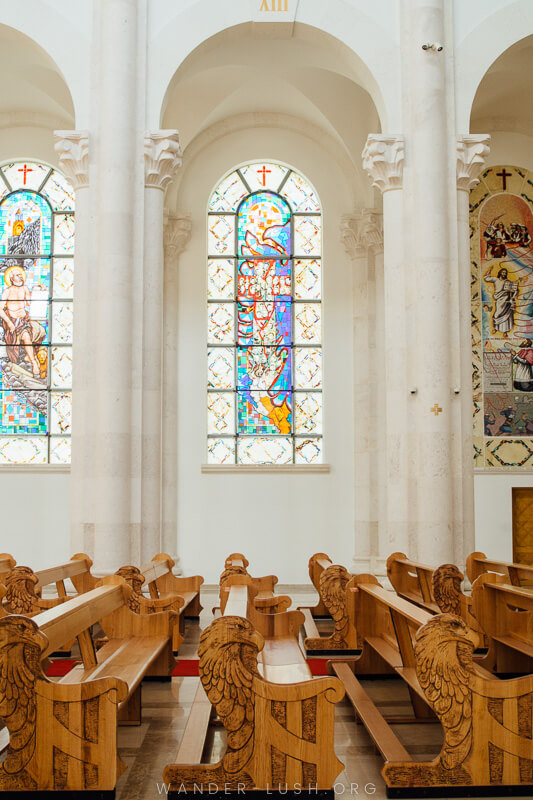















Up-date on the Newborn monument.
I visited it yesterday (my second visit to Prishtina, 3 days last year was not enough, I love Kosovo and the Albanians, so kind and helpful) and this time around the letters now in blue and yellow (the Ukrainian colours I guess) have been moved around: NONEWBR (with the words ‘broken’ and ‘republic’ written on the last two letters.
Right now I’m sipping a coffee inside the National Library, I love the tiles and the whole ‘vintage’ style. It’s definitely worth a visit.
Thanks so much for your update, Jane! I saw some photos online of the new Newborn. Have a terrific time in Kosovo!
Emily, have you explored the Dragodan steps in Pristina? There are good restaurants up there. And also going up to Peja/Pec, Rogova mountain is worthy to mention. There are also log cabin restaurants there serving fresh trout and fresh bread. I love their Balkan salad!
Thanks Raul for the recommendations… I didn’t get to the Dragodan steps or restaurants in that area, but thanks to you it’s on the list for next time! We stayed a few nights in Peja and went ziplining in Rugova, it was great! I included it in my Kosovo itinerary but your suggestion to visit as a day trip is a great one.
Thanks again for the excellent Pristina tips!
You’ve forgotten to mention Proper Pizza, a franchise gone world wide, HQ in Prishtinë.
I’m sorry Italy for the second hit, but that Pizza is truly something else.
Ohhh I’m so devastated I missed it! Thank you so much for the excellent tip! Kosovo needs to start doing gelato!
I really liked reading your post! Very high quality content and useful information.
I would like to start from the cathedral tower to have an overview of the town before touring. I am quite amazed that there are more than 500 mosques! I love your photos.
I have no idea that Kosovo is not recognized by the UN as a nation state. And even more, I never thought Kosovo as the best places in Europe to have coffee. I don’t know whose the person behind the Newborn Monument to re-imagined and re-invigorated by painting it differently every year on their Independence Day, but I think it’s so creative!
The Prishtina market looks lovely and surely a great place to hang out. Also I love the views from the Cathedral tower. The significant Newborn monument sounds unique as it is being repainted each year. I really hope to make a visit to Prishtina someday.
Great guide to Prishtina! I love how the Newborn monument is revitalized every year to reflect what is happening in Kosovo or the world. I share your fascination with socialist style housing and definitely would be interested in visiting that. The Balkans is such an interesting area to travel to.
Thanks, Brianna! Absolutely – our 6-month Balkans trip has been full of pleasant surprises!
Oh, It’s too good. I like this blog very much I also bookmark this.
Wow, what a guide! We traveled through this region a couple summers ago, and unfortunately never made it to Kosovo. But everyone we talked to LOVED it. And after reading this article (and seeing your beautiful photos!) I’m more convinced than ever to get back to this region and make it to Kosovo next time!
One for next time, Katie! It was definitely the highlight of the region (thus far) for us!
Prishtina looks like a great place with a bit of everything.to be honest I never heard about it before and loved reading your post,gathering information . Thanks for sharing
This is such a perfect itinerary for Prishtina. I truly did not know of this little known gem, but it looks so exciting. Your pictures are amazing. Thanks for sharing this.
I had no idea that there were so many amazing things to do in Prishtina! To be completely honest, I’d only heard of it in connection to war. I love the Newborn monument, and your photos of people sitting around chatting. It reminds me of my grandfather and his mates gathering in the village square every day.
Same for me, Katherine – that’s one of the things that made me curious to visit. It’s amazing to see how far things have come since that tragic time. Groups of men chatting on park benches will be one of the things I always remember about the Balkans!
I feel like I never gave either Prishtina or Kosovo the time they deserved. Prishtina was just a quick stop over between Skopje and Tirana and to be honest we only spent a few hours exploring the city – I didn’t even realise you could go inside the National Library. The Kurrizi housing estate sounds of particular interest! Either way this part of the world is so underrated – glad you seem to be enjoying it 🙂
A lot of people just use the city as a stopover, but it’s definitely worth spending a few days! I much preferred it to Skopje. Hope you make it back.
Wow thank you for such a complete guide to the city! I would love to visit Prishtina market. I think that would be my favorite part :).